When you embark on the search for the perfect diamond for your engagement ring, you’ll encounter a diverse array of diamond shapes. However, you may notice that some of them bear a resemblance to each other, such as radiant cuts and cushions.
The question arises: Which diamond shape is the right choice for you – radiant cut or cushion cut?
Although these two diamond shapes may appear similar at first glance, they are distinct from each other. In this article, we will explore both of these popular gem shapes and highlight their key differences.
So, let’s delve into the details and learn more about the radiant cut and cushion cut diamonds!
DESIGN YOUR OWN ENGAGEMENT RING: START WITH A SETTING OR START WITH A DIAMOND. IT’S REALLY UP TO YOU!
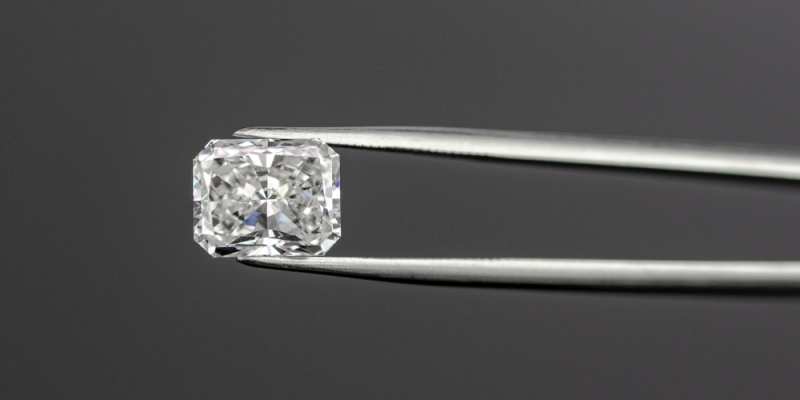
What Is Radiant Cut Diamond?
Back in 1977, Henry Grossbard conceptualized the radiant cut diamond as a fusion of the round brilliant cut and the emerald cut. Since its inception, the radiant cut has lived up to its name by showcasing impressive brightness and brilliance.
The radiant cut owes its stunning radiance to its remarkable 70 facets. Each facet is meticulously crafted to maximize brilliance and sparkle. While the radiant cut may not quite match the sheer brilliance of the round brilliant cut, it comes remarkably close.
This makes the radiant cut an excellent choice for engagement rings that exude brilliance and fiery sparkle.
Notably, the radiant cut diamonds feature carefully beveled edges, granting them exceptional durability against breakage. This attribute makes them an ideal option for individuals leading an active lifestyle. Additionally, the beveled edges allow radiant cut diamonds to be paired seamlessly with both square and rounded diamonds, expanding the design possibilities for your engagement ring.
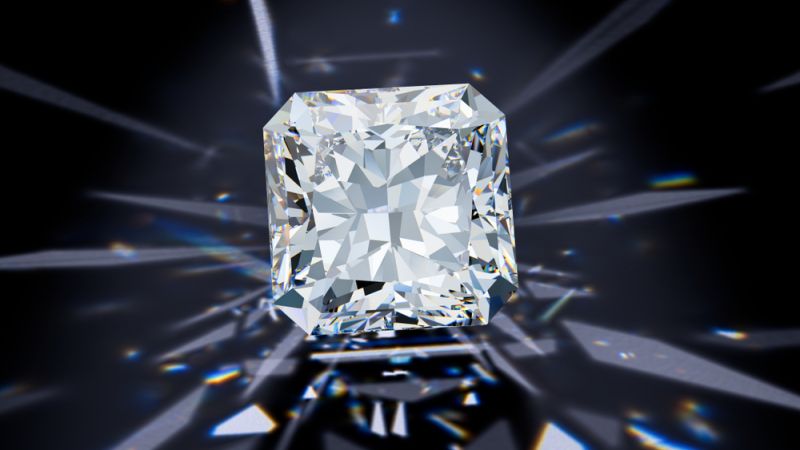
Radiant Cut Diamonds: Pros And Cons
Similar to any other diamond cut, radiant cut diamonds come with their own set of advantages and disadvantages. Let’s explore the benefits of radiant cut diamonds:
- Excellent Brilliance, Fire, and Sparkle:
Although the radiant cut diamond may not match the brilliance of the round brilliant cut, it still offers impressive sparkle and fire. With its 70 facets, the radiant cut diamond showcases excellent brilliance, making it a great choice for those seeking a non-round diamond shape with beautiful sparkle. - Larger Perceived Size:
One notable advantage of the radiant cut is that it tends to appear larger than other diamond shapes of the same carat weight. While the face-up area of a radiant cut diamond may be slightly smaller than a round brilliant cut, its long diagonal measurement creates an optical illusion, making it appear more substantial on the finger. - Better Durability:
Compared to square diamonds like the princess cut, the radiant cut diamond offers enhanced durability. Its beveled corners reduce the risk of chipping or breaking, making it a suitable option for individuals with active lifestyles. - Excellent Value for Money:
The cutting process of radiant cut diamonds utilizes a higher percentage of the rough stone, resulting in less wastage. As a result, loose radiant cut diamonds tend to be more affordable per carat compared to many other diamond shapes. Opting for a radiant cut can allow you to save money and potentially invest in a larger stone or an elaborate engagement ring setting.
However, it’s important to note the potential weakness of radiant cut diamonds:
- No GIA Cut Quality Grades:
While the cut quality of a diamond significantly impacts its overall appearance, the Gemological Institute of America (GIA) does not provide cut quality grades specifically for radiant cut diamonds. Assessing the cut quality of a radiant cut diamond requires a careful examination on an individual basis.
In conclusion, radiant cut diamonds offer excellent brilliance, a larger appearance, durability, and good value for money. However, it is crucial to evaluate the cut quality personally, as there are no standardized GIA cut grades for this particular diamond shape.

Radiant Cut Diamond: Length-To-Width Ratio
The length-to-width ratio of a diamond refers to the proportionality of the gem in relation to its intended shape, determined by dividing the length of the stone by its width.
For instance, if a diamond has a length of 5 millimeters and a width of 3.5 millimeters, the length-to-width ratio of that diamond would be 1.43.
The choice of length-to-width ratio for a radiant cut diamond is entirely subjective and depends on your personal perception of beauty.
Typically, the range for length-to-width ratios of radiant cut diamonds falls between 1.00 and 1.35. A lower ratio suggests a more square shape, while ratios above 1.35 tend to create a more elongated or rectangular appearance. In some cases, length-to-width ratios can even go up to 2.0, resulting in a distinctly rectangular-looking form.
Ultimately, the ideal length-to-width ratio for your radiant cut diamond should align with your aesthetic preferences and the visual appeal you desire for your diamond’s shape.
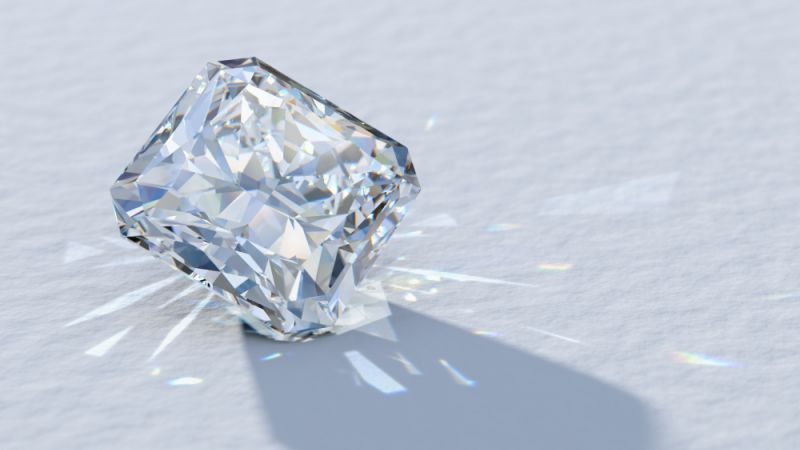
Why Do Radiant Cut Diamonds Look Bigger?
As mentioned earlier, radiant cut diamonds have a tendency to appear larger than other diamond shapes of the same carat weight. This characteristic was not accidental.
When Henry Grossbard designed this diamond shape in the 1970s, his intention was to create a cut that maximized the visual impact of each stone. Rather than focusing solely on maximizing the diamond’s weight, as was the common approach at the time, Grossbard aimed to enhance the natural beauty of the diamond.
The broad and shallow design of the radiant cut diamond allows more of the stone to be visible when set in a ring, creating the illusion of a larger diamond. This unique design combines the brilliance of a brilliant cut diamond with a perceived increase in size.
In summary, the radiant cut diamond’s ability to create a larger appearance is a result of its thoughtful design, which prioritizes showcasing the diamond’s beauty rather than solely focusing on its weight.

What Is A Cushion Cut Diamond?
The cushion cut diamond is a captivating blend of the modern round brilliant cut pattern and the timeless old mine pattern. This diamond shape typically features a soft square or rectangular shape with gently curved corners.
In essence, the cushion cut combines the elegance of a square cut with the charm of rounded edges, resembling a cushion or pillow, hence its name. While cushion-cut diamonds are commonly chosen for engagement rings, they are also used in various fashion pieces.
Compared to round brilliant-cut diamonds, cushion-cut gems are often priced lower. However, it’s important to note that the cost of cushion-cut diamonds can vary significantly due to their increasing popularity in recent times.
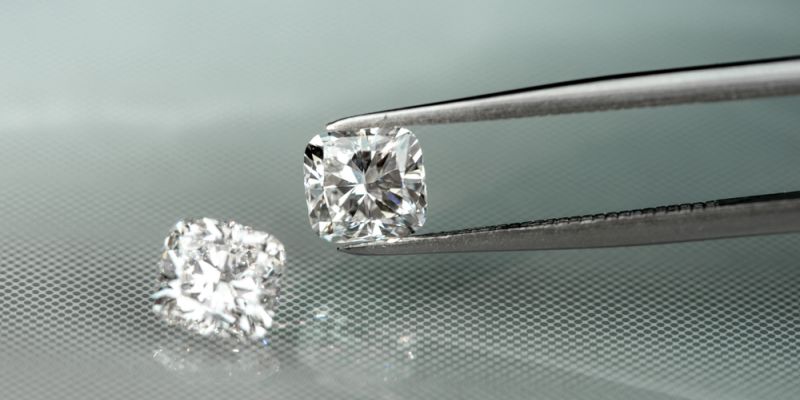
Cushion Cut Diamonds: Pros And Cons
Like any other diamond shape, the cushion-cut diamond has its own set of pros and cons:
Pros:
- High level of brilliance and fire: Cushion-cut diamonds exhibit exceptional brilliance and fire, captivating with their scintillation.
- Unique shape for a more personalized ring: The distinct shape of the cushion cut offers a unique and personalized look for engagement rings or other jewelry pieces.
- Very durable because of the rounded corners: The rounded corners of cushion-cut diamonds enhance their durability, making them less prone to chipping or damage.
- Combine classic fashion with modern flair: Cushion-cut diamonds seamlessly blend classic elegance with a touch of modern sophistication, making them a versatile choice for various styles.
- Less expensive compared to round brilliant cut diamonds: In general, cushion-cut diamonds are priced more affordably than round brilliant-cut diamonds, offering a cost-effective option.
- Rising in popularity: Cushion-cut diamonds have gained increasing popularity among diamond enthusiasts and those seeking a distinctive and timeless look.
Cons:
- Retains color better than other cuts: Due to their unique faceting pattern, cushion-cut diamonds may retain color more noticeably compared to other diamond cuts. Choosing a higher color grade can help mitigate this effect.
- Open table means inclusions are easier to spot: The large open table of cushion-cut diamonds may make inclusions or imperfections more visible. Selecting a higher clarity grade can help minimize this issue.
- Referred to by a number of terms which leads to confusion: The cushion-cut diamond is sometimes referred to by various terms such as “pillow-cut” or “candlelight-cut,” which can lead to confusion or ambiguity when searching for specific diamond characteristics.
Ultimately, when considering a cushion-cut diamond, it’s important to weigh these factors and prioritize the aspects that align with your preferences and priorities.
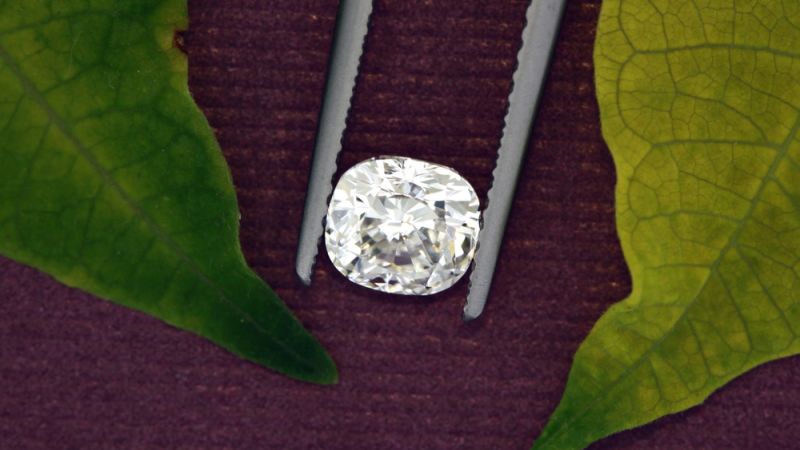
The Misunderstood Cushion Cut
Cushion-cut diamonds have gained immense popularity in recent times, thanks to their ability to exude elegance and sophistication while delivering a dazzling level of brilliance comparable to round brilliant cut diamonds.
However, the world of cushion cuts can be quite perplexing. It’s essential to familiarize yourself with a range of terms associated with cushion-cut diamonds to navigate this unique category effectively. These terms include classic cushions, modified cushions, broken glass, chunky cushions, and crushed ice, each referring to distinct variations within the cushion cut family.
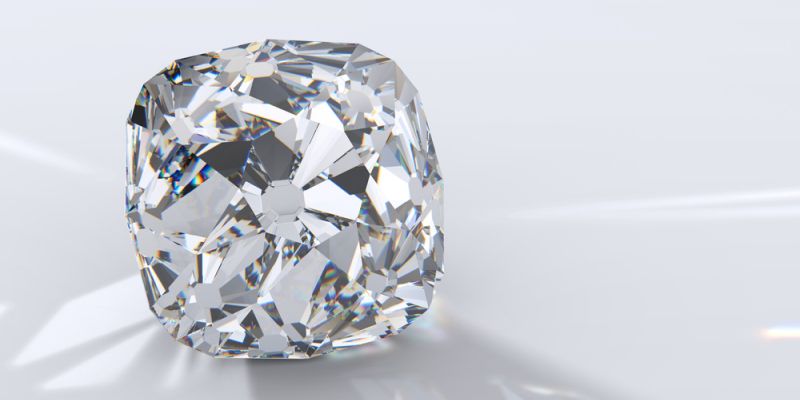
Standard Cushion Vs. Modified Cushion
Modern cushion cuts can be categorized into two main types: standard and modified cuts.
The differences between these two categories are relatively subtle, and their impact on a diamond’s appearance is generally minimal.
The primary distinction lies in their historical background. Standard cushions are the result of cutting styles that have been around for a longer time, while modified cushions represent modern variations of the original cushion cut patterns.
However, it is important to debunk a common misconception surrounding cushion cut diamonds. Some people may advise that you should opt for a standard cushion if you desire a chunky cushion gem, or choose a modified cushion for a crushed ice cushion appearance. In reality, this advice is largely inaccurate.
The truth about cushion cut diamonds is that there is typically no significant difference in the stone’s appearance, whether it is a standard or modified cut. The distinctions between the two categories rarely have noticeable effects on the overall look of the diamond.
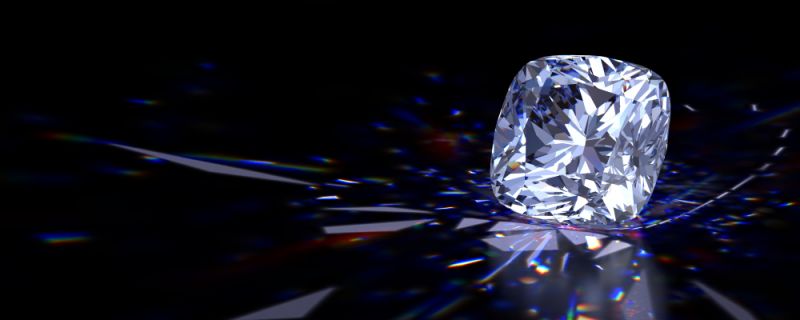
Chunky Cushion Cut Vs. Crushed Ice Cushion Cut
Cushion cut diamonds can exhibit two distinct looks, categorized as chunky cushions and crushed ice cushions.
Chunky Cushions:
Chunky cushion cuts are characterized by clearly defined patterns of facets visible when looking down into the diamond’s table. These diamonds often resemble the presentation of round brilliant cut diamonds and are sometimes referred to as antique cushion cuts. It’s important to note that while the cushion cut is a relatively modern style, it draws inspiration from the antique old mine cut.
Crushed Ice Cushions:
Crushed ice cushion cut gems display a unique appearance when viewed through the diamond’s table. These stones lack discernible faceting, giving the impression of broken glass or crushed ice—a scattered arrangement of sparkling brilliance. This effect is typically associated with radiant cut diamonds and can also be observed in the edges of marquise-shaped and pear-shaped stones.
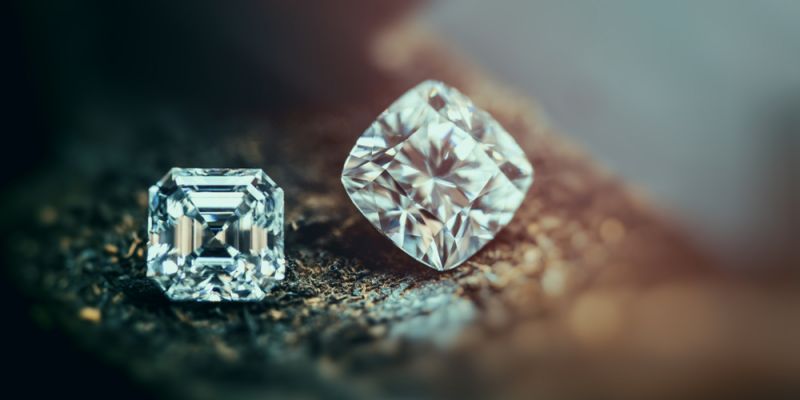
Radiant Cut Vs. Cushion Cut: Design
At first glance, radiant cut diamonds and cushion cut diamonds may appear similar. They both have large tables and facet patterns that contribute to their impressive brilliance. However, upon closer examination, there is a key distinction between the two:
Radiant cut diamonds feature beveled edges cut at a 45-degree angle, resulting in a more geometric and angular shape.
Cushion-cut diamonds, on the other hand, have curved and rounded corners, giving them a shape that combines elements of both a rectangle and a circle. By observing the corners, you can differentiate between a radiant cut diamond and a cushion cut diamond.
Additionally, while there can be variations, there is often a difference in the length-to-width ratio between radiant and cushion cut diamonds. Radiant diamonds can come in various length-to-width ratios, offering more flexibility in shape, while the cushion cut typically has a length-to-width ratio ranging from 1.00 to 1.09.
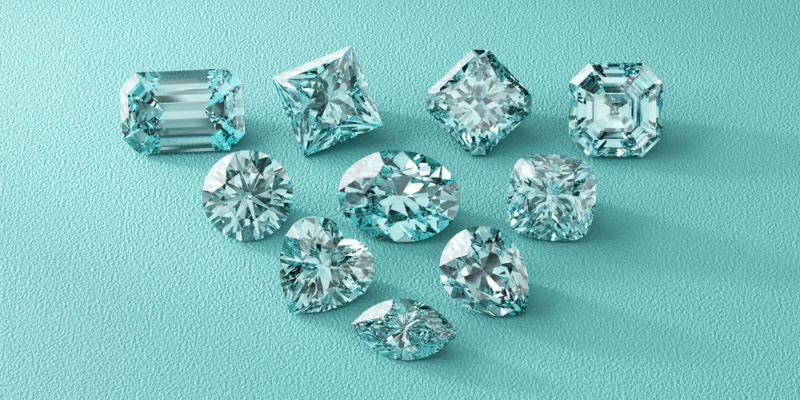
Radiant Cut Vs. Cushion Cut: Brilliance
The brilliance of a diamond is influenced by various factors, with the quality of the cut being one of the key determinants. A well-cut diamond will exhibit greater brilliance compared to a poorly cut stone. However, certain diamond shapes are renowned for their exceptional brilliance.
In general, the radiant cut is known for displaying more brilliance than the cushion cut. This can be attributed to the radiant cut’s large table, which allows for the intake and reflection of a higher amount of light, resulting in a captivating sparkle.
While cushion-cut diamonds also reflect light and produce a notable sparkle, they are particularly celebrated for their fire, which refers to their ability to disperse colored light, creating a captivating play of hues.

Bottom Line
So, when comparing radiant cut vs. cushion cut, these key points can help you determine which diamond shape suits you best.
- Durability: Both radiant cuts and cushion cuts have beveled corners, making them durable. Radiant cut diamonds have distinct edges, while cushion cut diamonds have rounded edges.
- Brilliance: Radiant cut diamonds offer slightly more brilliance due to their large table and numerous facets. They provide impressive sparkle.
- Fire: Cushion-cut diamonds are known for their fire, which refers to their ability to disperse colored light. Well-cut cushion diamonds generally exhibit more fire than radiant cut diamonds.
- Shape: Cushion cut diamonds tend to be more square in shape, with a length-to-width ratio typically between 1.0 and 1.09. Radiant and cushion cuts come in various square and rectangular forms.
- Personal preference: Ultimately, choosing between radiant and cushion cuts is a matter of personal preference. Consider your personal style and what appeals to you the most.
By considering these factors, you can make an informed decision about whether a radiant cut or cushion cut diamond is the right choice for you.


